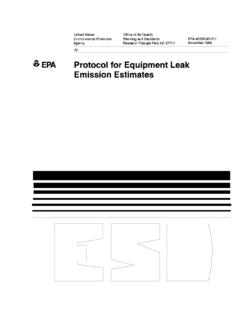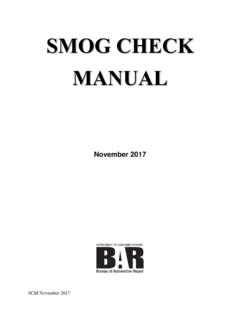Transcription of Leak Detection and Repair
1 Leak Detection and Repair A Best Practices Guide United States Environmental Protection Agency Of ce of Compliance Of ce of Enforcement and Compliance Assurance 1200 Pennsylvania Avenue, NW. (mail code). Washington, DC 20460. Disclaimer The Environmental Protection Agency (EPA) has reviewed this document and approves it for publication. This document does not constitute rulemaking by the EPA and may not be relied on to create a substantive or procedural right or bene t enforceable at law or in equity, by any person. The EPA may take actions at variance with this document and its internal procedures. Contents Purpose .. 1. Why Regulate Equipment Leaks? .. 2. Sources, Causes And Control Of Equipment Leaks .. 3. How are emissions from equipment leaks reduced? .. 3. What regulations incorporate LDAR programs? .. 6. What Are the Bene ts of an LDAR Program?
2 7. Reducing Product Losses .. 8. Increasing Safety for Facility Workers and Operators .. 8. Decreasing Exposure for the Surrounding Community .. 8. Potentially Reducing Emission Fees .. 8. Avoiding Enforcement Actions .. 8. Elements of an LDAR Program .. 9. What Compliance Problems Have Been Found With Current LDAR. Programs? .. 15. Model LDAR Program .. 19. Written LDAR Program .. 20. Training .. 20. LDAR Audits.. 21. Contractor Accountability .. 22. Internal Leak De nition for Valves and Pumps .. 22. More Frequent Monitoring .. 23. Repairing Leaking Components.. 23. Delay of Repair Compliance Assurance .. 24. Electronic Monitoring and Storage of LDAR Data .. 24. QA/QC of LDAR Data .. 25. Calibration/Calibration Drift Assessment .. 25. Records Maintenance .. 26. Sources of Additional Information .. 27. Tables Table Sources of equipment leaks.
3 4. Table Equipment component counts at a typical re nery or chemical plant.. 5. Table Uncontrolled VOC emissions at a typical facility.. 5. Table Control effectiveness for an LDAR program at a chemical process unit and a re nery.. 7. Leak Detection and Repair Compliance Assistance Guidance A Best Practices Guide Appendices Appendix A Federal Regulations That Require a Formal LDAR Program With Method 21 .. 29. Appendix B Federal Regulations That Require the Use of Method 21. But Do Not Require a Formal LDAR Program .. 30. Appendix C Method 21 General Procedure .. 31. Appendix D Method 21 Determination of Volatile Organic Compound Leaks .. 32. Appendix E Summary of NEIC Comparative Monitoring Results of Leaking Valves at 17 Re neries .. 39. Appendix F Enforcement Alert .. 40. Leak Detection and Repair A Best Practices Guide Purpose In general, EPA has found significant widespread Some of the elements of a model LDAR program, noncompliance with Leak Detection and Repair as described in Section , are required by current (LDAR) regulations and more specifically, noncom Federal regulations.
4 Other model LDAR program pliance with Method 21 requirements. In 1999, EPA elements help ensure continuous compliance al . estimated that, as a result of this noncompliance, though they may not be mandated from a regulato . an additional 40,000 tons of VOCs are emitted an ry standpoint. Furthermore, State or local require . nually from valves at petroleum refineries alone. ments may be more stringent than some elements of the model LDAR program, such as with leak This document is intended for use by regulated definitions. Prior to developing a written LDAR. entities as well as compliance inspectors to identify program plan, all applicable regulations should be some of the problems identified with LDAR pro . reviewed to determine and ensure compliance with grams focusing in on Method 21 requirements and the most stringent requirements. describe the practices that can be used to increase the effectiveness of an LDAR program.
5 Specifically, this document explains: The importance of regulating equipment leaks;. The major elements of an LDAR program;. Typical mistakes made when monitoring to detect leaks;. Problems that occur from improper manage . ment of an LDAR program; and A set of best practices that can be used to implement effective an LDAR program. 1. Leak Detection and Repair A Best Practices Guide Why Regulate Equipment Leaks? EPA has determined that leaking equipment, such where refineries and chemical facilities are located, as valves, pumps, and connectors, are the largest do not meet the National Ambient Air Quality source of emissions of volatile organic compounds Standard (NAAQS) for ozone. Ozone can be trans . (VOCs) and volatile hazardous air pollutants ported in the atmosphere and contribute to nonat . (VHAPs) from petroleum refineries and chemical tainment in downwind areas.
6 Manufacturing facilities. The Agency has estimated Some species of VOCs are also classified as VHAPs. that approximately 70,367 tons per year of VOCs Some known or suspected effects of exposure to and 9,357 tons per year of HAPs have been emitted VHAPs include cancer, reproductive effects, and from equipment leaks. emissions from equipment birth defects. The highest concentrations of VHAPs leaks exceed emissions from storage vessels, waste . tend to be closest to the emission source, where water, transfer operations, or process vents. the highest public exposure levels are also often VOCs contribute to the formation of ground-level detected. Some common VHAPs emitted from re . ozone. Ozone is a major component of smog, and fineries and chemical plants include acetaldehyde, causes or aggravates respiratory disease, particu benzene, formaldehyde, methylene chloride, naph.
7 Larly in children, asthmatics, and healthy adults thalene, toluene, and xylene. who participate in moderate exercise. Many areas of the United States, particularly those areas According to EPA's 2002 National emissions Inventory (NEI) database, 125,000 tons per year (tpy) of VOC are emitted from petroleum re ner- ies. It is estimated that over 49,000 tpy of VOC. from re neries are equipment leak emissions . Of the 165,000 tpy of VOC emissions from chemical manufacturing facilities, 21,000 tpy is attributable to equipment leaks. 2. Leak Detection and Repair A Best Practices Guide Sources, Causes And Control Of Equipment Leaks A typical refinery or chemical plant can emit 600 by modifying the equipment or component. 700 tons per year of VOCs from leaking equipment, emissions from pumps and valves can also be such as valves, connectors, pumps, sampling con reduced through the use of leakless valves nections, compressors, pressure-relief devices, and and sealless pumps.
8 Common leakless open-ended lines. valves include bellows valves and diaphragm valves, and common sealless pumps are dia . Table shows the primary sources of emissions phragm pumps, canned motor pumps, and from components subject to equipment leak regu . magnetic drive pumps. Leaks from pumps lations. In a typical facility, most of the emissions can also be reduced by using dual seals with are from valves and connectors because these are or without barrier fluid. the most prevalent components and can number in the thousands (Table ). The major cause of emis . Leakless valves and sealless pumps are ef . sions from valves and connectors is seal or gasket fective at minimizing or eliminating leaks, failure due to normal wear or improper mainte . but their use may be limited by materials nance. of construction considerations and process Previous EPA studies have estimated that valves operating conditions.
9 Installing leakless and and connectors account for more than 90% of emis sealless equipment components may be a sions from leaking equipment with valves being the wise choice for replacing individual, chronic most significant source (Table ). Newer informa leaking components. tion suggests that open-ended lines and sampling connections may account for as much as 5-10% of LDAR is a work practice designed to total VOC emissions from equipment leaks. identify leaking equipment so that emissions can be reduced through repairs. A com . How are emissions from equipment leaks ponent that is subject to LDAR requirements must be reduced? monitored at speci ed, regular intervals to determine whether or not it is leaking. Any leaking component Facilities can control emissions from equipment must then be repaired or replaced within a speci ed time frame. leaks by implementing a leak Detection and Repair (LDAR) program or by modifying/replacing leak.
10 Ing equipment with leakless components. Most equipment leak regulations allow a combination of both control methods. Leaks from open-ended lines, compressors, and sampling connections are usually fixed 3. Leak Detection and Repair A Best Practices Guide Table Sources of equipment leaks. Pumps are used to move uids from one point to Leaks from pumps typically occur at the seal. another. Two types of pumps extensively used in pe . troleum re neries and chemical plants are centrifugal pumps and positive displacement, or reciprocating pumps. Valves are used to either restrict or allow the move Leaks from valves usually occur at the stem or gland ment of uids. Valves come in numerous varieties and area of the valve body and are commonly caused by a with the exception of connectors, are the most com failure of the valve packing or O-ring. mon piece of process equipment in industry.











